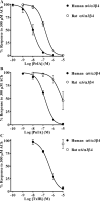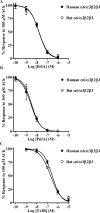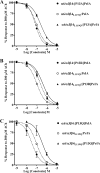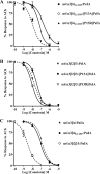Molecular determinants of α-conotoxin potency for inhibition of human and rat α6β4 nicotinic acetylcholine receptors
- PMID: 30249616
- PMCID: PMC6240866
- DOI: 10.1074/jbc.RA118.005649
Molecular determinants of α-conotoxin potency for inhibition of human and rat α6β4 nicotinic acetylcholine receptors
Abstract
Nicotinic acetylcholine receptors (nAChRs) containing α6 and β4 subunits are expressed by dorsal root ganglion neurons and have been implicated in neuropathic pain. Rodent models are often used to evaluate the efficacy of analgesic compounds, but species differences may affect the activity of some nAChR ligands. A previous candidate α-conotoxin-based therapeutic yielded promising results in rodent models, but failed in human clinical trials, emphasizing the importance of understanding species differences in ligand activity. Here, we show that human and rat α6/α3β4 nAChRs expressed in Xenopus laevis oocytes exhibit differential sensitivity to α-conotoxins. Sequence homology comparisons of human and rat α6β4 nAChR subunits indicated that α6 residues forming the ligand-binding pocket are highly conserved between the two species, but several residues of β4 differed, including a Leu-Gln difference at position 119. X-ray crystallography of α-conotoxin PeIA complexed with the Aplysia californica acetylcholine-binding protein (AChBP) revealed that binding of PeIA orients Pro13 in close proximity to residue 119 of the AChBP complementary subunit. Site-directed mutagenesis studies revealed that Leu119 of human β4 contributes to higher sensitivity of human α6/α3β4 nAChRs to α-conotoxins, and structure-activity studies indicated that PeIA Pro13 is critical for high potency. Human and rat α6/α3β4 nAChRs displayed differential sensitivities to perturbations of the interaction between PeIA Pro13 and residue 119 of the β4 subunit. These results highlight the potential significance of species differences in α6β4 nAChR pharmacology that should be taken into consideration when evaluating the activity of candidate human therapeutics in rodent models.
Keywords: X-ray crystallography; analgesic; neuroinflammation; neuropathic pain; neuroscience; neurotoxin; neurotransmitter receptor; nicotinic acetylcholine receptors (nAChR); nicotinic subunit α6; nicotinic subunit β4; nuclear magnetic resonance spectroscopy; small peptide; α1;-conotoxin.
Conflict of interest statement
The authors declare that they have no conflicts of interest with the contents of this article
Figures











Similar articles
-
α-Conotoxin PeIA[S9H,V10A,E14N] potently and selectively blocks α6β2β3 versus α6β4 nicotinic acetylcholine receptors.Mol Pharmacol. 2012 Nov;82(5):972-82. doi: 10.1124/mol.112.080853. Epub 2012 Aug 22. Mol Pharmacol. 2012. PMID: 22914547 Free PMC article.
-
Key Structural Determinants in the Agonist Binding Loops of Human β2 and β4 Nicotinic Acetylcholine Receptor Subunits Contribute to α3β4 Subtype Selectivity of α-Conotoxins.J Biol Chem. 2016 Nov 4;291(45):23779-23792. doi: 10.1074/jbc.M116.730804. Epub 2016 Sep 19. J Biol Chem. 2016. PMID: 27646000 Free PMC article.
-
α-Conotoxin [S9A]TxID Potently Discriminates between α3β4 and α6/α3β4 Nicotinic Acetylcholine Receptors.J Med Chem. 2017 Jul 13;60(13):5826-5833. doi: 10.1021/acs.jmedchem.7b00546. Epub 2017 Jun 21. J Med Chem. 2017. PMID: 28603989 Free PMC article.
-
Residues Responsible for the Selectivity of α-Conotoxins for Ac-AChBP or nAChRs.Mar Drugs. 2016 Oct 11;14(10):173. doi: 10.3390/md14100173. Mar Drugs. 2016. PMID: 27727162 Free PMC article. Review.
-
The Structural Features of α-Conotoxin Specifically Target Different Isoforms of Nicotinic Acetylcholine Receptors.Curr Top Med Chem. 2015;16(2):156-69. doi: 10.2174/1568026615666150701114831. Curr Top Med Chem. 2015. PMID: 26126912 Review.
Cited by
-
Stereoisomers of Chiral Methyl-Substituted Symmetric and Asymmetric Aryl Piperazinium Compounds Exhibit Distinct Selectivity for α9 and α7 Nicotinic Acetylcholine Receptors.ACS Chem Neurosci. 2025 Jul 16;16(14):2665-2681. doi: 10.1021/acschemneuro.5c00204. Epub 2025 Jun 30. ACS Chem Neurosci. 2025. PMID: 40587620 Free PMC article.
-
Nicotinic Acetylcholine Receptor Partial Antagonist Polyamides from Tunicates and Their Predatory Sea Slugs.ACS Chem Neurosci. 2021 Jul 21;12(14):2693-2704. doi: 10.1021/acschemneuro.1c00345. Epub 2021 Jul 2. ACS Chem Neurosci. 2021. PMID: 34213884 Free PMC article.
-
Computational Design of α-Conotoxins to Target Specific Nicotinic Acetylcholine Receptor Subtypes.Chemistry. 2024 Feb 1;30(7):e202302909. doi: 10.1002/chem.202302909. Epub 2023 Dec 18. Chemistry. 2024. PMID: 37910861 Free PMC article.
-
Alkaloid ligands enable function of homomeric human α10 nicotinic acetylcholine receptors.Front Pharmacol. 2022 Sep 16;13:981760. doi: 10.3389/fphar.2022.981760. eCollection 2022. Front Pharmacol. 2022. PMID: 36188578 Free PMC article.
-
α-Conotoxins and α-Cobratoxin Promote, while Lipoxygenase and Cyclooxygenase Inhibitors Suppress the Proliferation of Glioma C6 Cells.Mar Drugs. 2021 Feb 21;19(2):118. doi: 10.3390/md19020118. Mar Drugs. 2021. PMID: 33669933 Free PMC article.
References
-
- Salminen O., Murphy K. L., McIntosh J. M., Drago J., Marks M. J., Collins A. C., and Grady S. R. (2004) Subunit composition and pharmacology of two classes of striatal presynaptic nicotinic acetylcholine receptors mediating dopamine release in mice. Mol. Pharmacol. 65, 1526–1535 10.1124/mol.65.6.1526 - DOI - PubMed
Publication types
MeSH terms
Substances
Associated data
- Actions
- Actions
Grants and funding
LinkOut - more resources
Full Text Sources
Other Literature Sources

